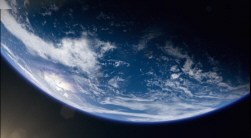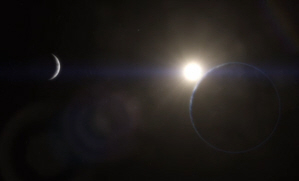Transforming Energy
Cosmological Evolution
What is Life?

Energy created Earth
To understand how energy sustains life, you have to understand exactly what happens to it as the cosmos evolves.
In the first instance after the Big Bang there was nothing in the universe but energy. As it changed from one form to another, galaxies, stars and
planets were born. But while the total amount of energy in the universe stays constant, with every single transformation something that does is change.
The energy itself becomes less and less useful. It becomes ever more disordered.
And you can see this process in action as energy from the sun hits the surface of the Earth.
So think about this sand on the beach, it's been under the glare of the sun all day, it's been absorbing its light which has been heating it up, and
now that the sun is dipping below the horizon, then the sand is still hot to the touch because it's re-radiating all the energy that it absorbed
as heat back into the universe. The key word there is "all". All the energy. If it didn't do that then it would just gradually heat up day after day
after day, and eventually, I suppose, the whole beach would melt. So what's changed?

Brian Cox examining Sand
Well, it's the quality of the energy, if you like. Think about it. If as much energy is coming back off this sand now as it absorbed from the
sun, then it should be giving me a sun tan. I should need sun cream if I sit looking at this beach all night. And obviously I don't. The difference
is that this energy is of a lower quality. It can do less. It's heat, which is a very low quality of energy indeed. So what the sand's done is take
highly ordered, high-quality energy from the sun and converted to an equal amount of low quality disordered energy.
This descent into disorder is happening across the entire universe.
As time passes, every single joule of energy is converted into heat. The universe gradually cools towards absolute zero. Until with no ordered
energy left, the cosmos grinds to a halt and every structure in it decays away.
Yet whilst universe is dying, everywhere you look life goes on. It's a deep paradox that Schroedinger was well aware of when he wrote his book in 1943.
"How can it be," wrote Schroedinger," that the living organism avoids decay?". In other words, how can it be that life seems to continue to
build increasingly complex structures when the rest of the universe is falling to bits, is decaying away?
Now, that's a paradox, because the universe is falling to bits, it is tending towards disorder. That is enshrined in a law of physics called
the Second Law of Thermodynamics. And I think most physicists believe that it's the one law of physics that will never be broken.

Thermal Camera
The key to understanding how life obeys the laws of thermodynamics is to look at both the energy it takes in and the energy it gives out.
This is a thermal camera, so hot things show up as red, and cold things show up as blue. So what you're seeing here is that the chicken (off screen)
is hotter than its surroundings. Now, heat is a highly disordered form of energy, so the chicken is radiating disorder out into the wider universe.
By converting chemical energy into heat, life transforms energy from an ordered to a disordered form, in exactly the same way as every other
process in the universe. In fact, every single human being can generate 6,000 times more heat per kilogram than the sun. And it's by converting
so much energy from one form to another that life is able to hang on to a tiny amount of order for itself. Just enough to resist the inevitable
decay of the universe.
So it's no accident that living things are hot and export heat to their surroundings. Because it's an essential part of being alive. Living
things borrow order from the wider universe, and then they export it again as disorder. But it's not precisely in balance. The have to export more
disorder than the amount of order they import. That is the content of the Second Law of Thermodynamics. And living things have to obey the second
Law because they are physical structures, they obey the laws of physics.

Planets
Just by being alive, we too are part of the process of energy transformation that drives the evolution of the universe. We take sunlight that has
its origins at the very start of time, and transform it into heat that will last for eternity. So, far from being a paradox, living things can be
explained by the laws of physics. The very same laws that describe the falling of the rain and the shining of the stars.
The dragonfly draws its energy from proton gradients, the fundamental chemistry that powers life. But the real miracles are
the structures they build with that energy. Borrowing order to generate cells. Arranging those cells into tissues. And those tissues into the
intricate architecture of their bodies.
So we've developed a quite detailed understanding of the underlying machinery that powers these dragonflies, and indeed all life on Earth.
And whilst we don't have all the answers, it is certainly safe to say that there is no mysticism required. You don't need some kind of magical flame
to animate these little machines. They operate according to the laws of physics and I think they are no less magical for that.
Yet the dragonfly will only maintain this delicate balancing act for so long. Because all living things share the same fate. Each individual will
die. But life itself endures. This is because there is something that separates life from every other process in the universe.



